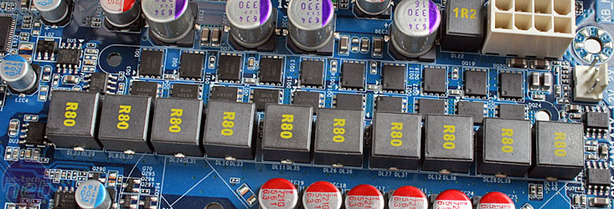Gigabyte's GA-X38T-DQ6:
We've already shown you a fair bit about Gigabyte's X38 motherboards, but there's so much more that we haven't told you about the board. That's what we're here to do today in our first look at Gigabyte's next flagship Intel motherboard.The last "DQ6" board (the GA-965P-DQ6) we looked at used the P965 chipset, and we thought was so great we gave it the coveted bit-tech Excellence Award. It's therefore fair to say that the GA-X38(T)-DQ6 has a lot to live up to.
Since we're addicted to all things new and shiny, like magpies with opposable thumbs, we have the "T" version here. The T denotes Three, or in other words it supports DDR3, while the non-T version of the board supports DDR2. Because of the current DDR3 memory prices, we suspect a significant number of people will be considering the non-T version, but that doesn't come with the extra memory technologies.
Both boards offer identical features apart from the memory difference, which we'll be covering in a later article when the chipset officially launches later in the month. Despite the fact we're only taking a first look here - so no box, bundle or extensive stress testing (and therefore there's no score) - we are taking a gander to see if it's indeed made of the same "excellence" material the GA-965P-DQ6 was made of.
Features:
- Support for LGA775 Intel Core 2 Quad and Core 2 Duo, including 1,333/1,066/800MHz FSB along with future 1,600MHz and 45nm processors
- Intel X38 Northbridge
- Intel ICH9R Southbridge
- Four DDR3 memory slots supporting 1,600MHz memory (or DDR2 1,066MHz on the GA-X38-DQ6)
- Two PCI Express x16 slots (both x16 bandwidth) with support for ATI CrossFire technology
- Three PCI Express x1 slots
- Two 32-bit v2.3 Master PCI bus slots (support 3.3v/5v PCI bus interface)
- One IDE port and two SATA 3Gbps ports supporting RAID 0, 1 from the Gigabyte controller
- Six SATA 3Gbps ports supporting RAID 0, 1, 0+1, 5 or JBOD from ICH9R
- Realtek ALC889a High-Definition audio codec with up to 24-bit/192KHz playback, 106dB SNR, as well as HDCP for Blu-ray and HD DVD discs and DTS Connect for surround sound effects.
- Two Gigabit Ethernet from PCI-Express Realtek RTL8111 chipsets
- Texas Instruments TSB43AB23 Firewire chipset for three IEEE1394a ports
- Twelve USB 2.0 ports
- Ultra Durable 2 technology
Board Layout


The familiar blue PCB that is used in all Gigabyte boards is not surprisingly back on the GA-X38T-DQ6. Even though this is the high end model again the DQ6 is not differentiated by visual attributes, only by features on the same six-layer PCB. The board has Ultra Durable 2 features which include Ferrite Core chokes, Lower RDS(on) Mosfets and Low ESR Solid Aluminium SMD (surface mount device) Capacitors.
The new mosfets have a smaller physical footprint and Gigabyte says they run cooler than previous designs. Specifically Low RDS(on) fets are used, as they're designed to produce a lower switching resistance for faster current charging/discharging. However they need a greater drive current as they have a lower gate capacitance but despite this they are still preferred by Gigabyte:
GIGABYTE uses Low RDS(on) MOSFETs because they do utilize lower power consumption due to their more efficient gate switching process. Energy consumption is becoming a more and more important issue especially with new energy regulations such as Energy Star Compliance. Making every component as energy efficient as possible is the goal to bringing total system power consumption down to the lowest level possible. In addition, they are able to better resist environmental changes (extreme high or low temperatures) and this is why you commonly see server boards and notebook motherboards using Low RDS(on) MOSFETs.Ferrite Cored Chokes are also used for a variety of reasons, some of which might not be that obvious at first:
Ferrite vs Iron CoresLow ESR solid aluminium SMD capacitors mean not only a significantly longer life but also less stray inductance. It also means the underside can't short or possibly cut you when you hold it.
GIGABYTE uses ferrite as the core material as opposed to the traditional iron core. Ferrite is able to hold energy longer than iron at higher frequencies. Because of this there is less core energy lost. In addition, ferrite also has less EMI and resists rust better (this is especially important for costal regions with high humidity and high concentrations of salt content in the air).
Covered vs Air
GIGABYTE also uses covered chokes as this helps to insulate and minimize the “hum” or noise. It also helps to prevent EMI and possible damage to the core.

SMD (Solid Mount Device) Capacitors vs DIP CapacitorsSo solid aluminium capped SMD capacitors are the way to go it seems. A lot of other companies have jumped on the solid aluminium variety in the last year, but most other companies are still using the DIP variety. It seems Gigabyte's manufacturing process is now tailored to SMD.
The manufacturing process for mounting SMD capacitors is more reliable as there is a high percentage of miss-soldering using DIP process. Often with DIP, the capacitor gets “cold mounted” (the temperature does not get hot enough to form a proper solder, but from the outside, the capacitor looks properly mounted). In addition, with DIP, the capacitors are often not straight when mounted, leading to a high percentage of failure mounts. In terms of actual performance, the SMD mounted capacitors offer better reliability and better heat resistance.
Solid vs Electrolytic Capacitors
GIGABYTE uses Solid Capacitors because they offer better stability, longer component lifespan and better electronic conductivity especially during high stress conditions including overclocking. In addition, GIGABYTE uses Solid in non-critical places to ensure not only better performance, but also to avoid the problem of budging or leaking electrolytic capacitors that has caused problems for many users.

MSI MPG Velox 100R Chassis Review
October 14 2021 | 15:04









Want to comment? Please log in.